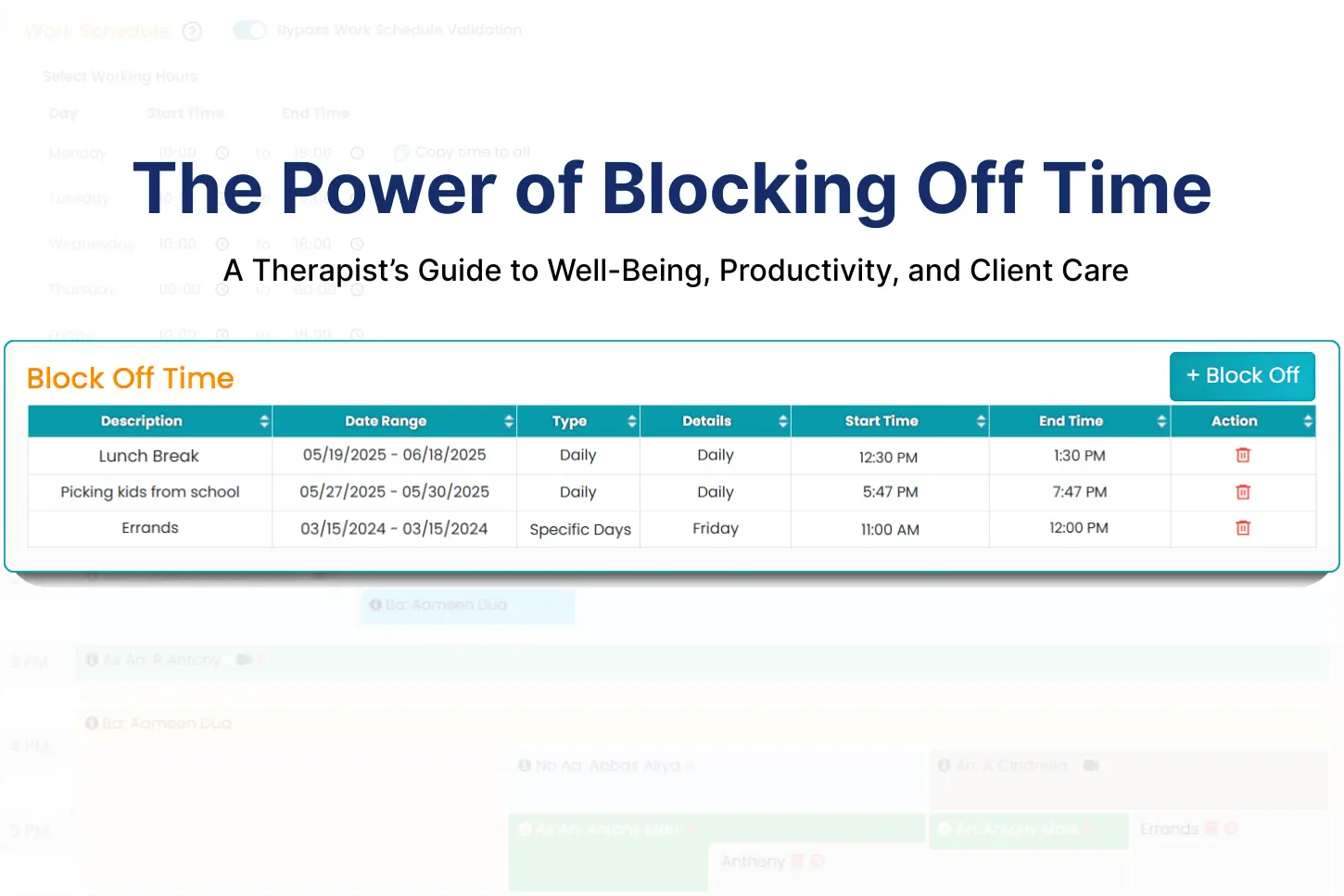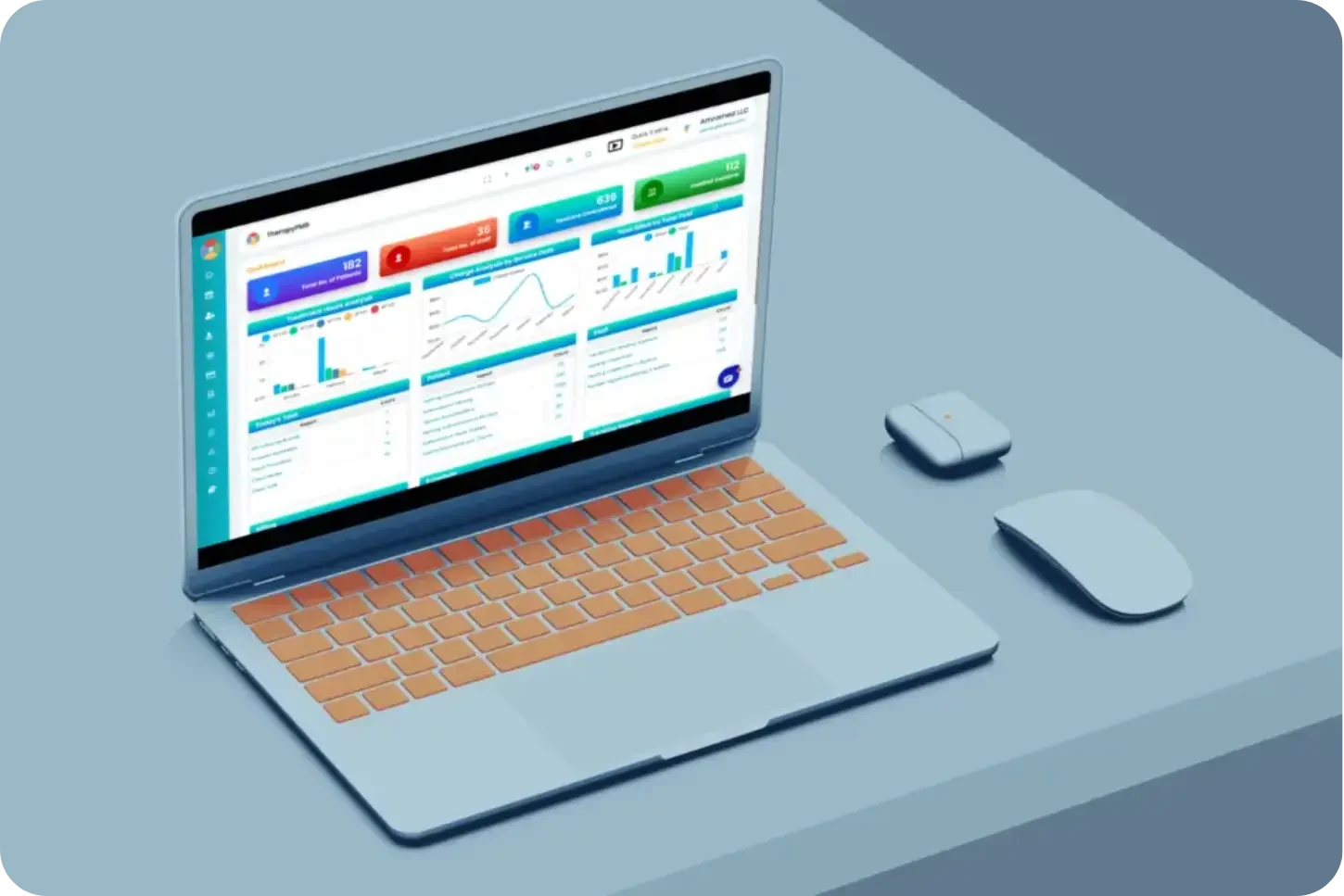
The Power of Block Off Time: A Therapist’s Guide to Well-Being, Productivity, and Client Care
Do you get stressed and frustrated after every session? Want to take a break or an extended vacation but feel guilty for not spending time with your patients? If so, you might be on the verge of burnout.
As a therapist, it is natural to feel empathetic towards patients and contribute to their well-being. However, it is also important to set boundaries whenever required to protect your physical, mental, and emotional well-being. You might think it is easier said than done. Nope!
TherapyPM has a feature called Block Off Time, which allows you to set boundaries while maintaining a therapeutic relationship with patients. It allows you to set aside time for yourself to refresh and rejuvenate before heading back to the therapy practice.
This blog will highlight the importance of blocking off time, ways to use it, maintaining a work-life balance, and how TherapyPM helps.
Key Takeaways
- Blocking off time helps therapists prevent burnout, maintain work-life balance, and provide better care for patients.
- Just like patients, therapists deserve self-care too—recharge, refocus, and rejuvenate for their mental, physical, and emotional well-being.
- TherapyPM simplifies scheduling, allowing therapists to block off time effortlessly, avoid overbooking, and maintain smooth practice operations.
- Prioritizing self-care and setting boundaries ensures therapists remain emotionally available and engaged during sessions.
- Have an open and honest communication with clients in advance regarding therapist availability and boundaries to foster trust and improve the therapeutic relationship.
Why is Blocking Off Time Essential?
Blocking off time is essential to maintaining an appropriate work-life balance. It helps therapists get a much-needed break from everyday activities and tasks and prevent burnout. This includes patient sessions and administrative tasks (in case you haven’t switched to practice management software yet).
Here are a few reasons blocking off time is essential:
Mental & Emotional Recharge:
Therapists often push themselves to the edge when they book sessions with patients. Sometimes, they resort to overbooking sessions. In this pursuit, therapists cannot take care of themselves. This leads to:
- Mental fatigue
- Compassion fatigue
- Burnout
- Reduced empathy for patients
Lack of proper breaks can eventually seep into your personal life too and affect your family relationships.
Practice What You Preach:
Just as you teach your patients to prioritize self-care, you must do the same for yourself. Scheduling a block off time can work wonders! Use block-off time to:
- Recharge your emotional energy
- Refocus your intentions
- Return to work with full attention and emotional availability
When you are well-rested, you can enhance therapeutic relationships by providing undivided focus and genuine support to patients.
Catch Up on Important Tasks:
Blocking off time also ensures you have dedicated periods for:
- Administrative tasks
- Session notes
- Professional development
It prevents last-minute chaos and scheduling conflicts while keeping your workflow organized and stress-free.
Sustain Your Career for the Long Term:
Blocking off time enables you to maintain your career in the long term. It allows you to:
- Build healthy habits
- Prevent burnout
- Provide consistent, high-quality care over the years.
Continue supporting your clients over the years without compromising your well-being.
Manual vs. Automated Blocking: What’s the Difference?
| Feature | Manual Blocking | Automated Blocking |
| Time to Block Off One Slot | 10-15 minutes Examples: Calls, emails, calendar edits | Under 1 minute Example: One-click |
| Risk of Overbooking | High Requires manual updates across systems | Low The system marks you unavailable automatically |
| Client Notification | Manual follow-ups via email/text | Automatic alerts are send in case a replacement is assigned |
| Calendar Syncing | Manual updates to all parties involved | Real-time sync across therapist & admin dashboards |
| Replacing Providers | Requires direct coordination and patient communication | Requires only a click on the “Assign Replacement” option |
| Tracking Time Off | Hard to analyze usage patterns | Shows detailed reports of blocked hours and trends |
| Stress & Admin Burden | High Prone to errors and miscommunication | Low Streamlined and error-proof |
How Can Therapists Make the Most Out of Their Block Off Time?
Taking a break doesn’t need to be grand. It doesn’t require you to do anything huge. All you need to do is take at least some time for yourself. Block off time is highly recommended for therapists to focus on their physical, mental, and emotional well-being. It can be as a long vacation or just a short-term vacation in which you spend time indoors.
Here’s how therapists like you can make the most of the block off time:
Prioritize Self-Care:
Use this time to reconnect with yourself. Even small activities can help you reset and feel more grounded:
- Take long baths or naps
- Cook your favorite meals or order takeout guilt-free
- Read books or listen to calming music
- Journal your thoughts or take mindful walks.
Invest in Professional Growth:
You can also use your block off time productively, without burning out, of course.
- Catch up on pending documentation
- Attend a CEU training session or webinar
- Reflect on the recent session to refine your clinical approach.
Spend Quality Time with Loved Ones:
Scheduling a block off time also allows you to spend time with family and friends. You can spend some time together:
- Watch movies or play games
- Plan a quick trip or beach day
- Cook meals together or simply chat over coffee
Never underestimate how refreshing shared laughter and connection can be!
Plan Smart Breaks with TherapyPM:
If you have scheduled a session for a particular day but need a break, canceling may not be feasible. In that case:
- Add a session break on TherapyPM and assign a replacement provider.
- Pro tip: Schedule short, regular block-off periods in advance to ensure a balanced workload without last-minute conflicts.
Explore Your Interests Without Guilt:
Make the most of your block off time without guilt. Try something new or return to something old:
- Pick up a forgotten hobby
- Try a new craft, art project, or creative writing
- Volunteer with a local non-profit
- Join a book club or try yoga
- Block-off time is not a luxury. Rather, it is a necessity. When you return refreshed, your patients and personal life will prosper. This is the perfect time for you to try out everything!
Maintaining Client Satisfaction While Setting Boundaries
As a therapist, the well-being of patients often lies in your hands, therefore, you dedicate maximum time to them. Setting boundaries is also essential for your well-being to provide even better care for your patients. It helps reduce burnout and stress, too.
However, the question pops up in your head.
“What would happen to my clients if I blocked off time for myself?”
“How would they feel?”
“Wouldn’t they feel betrayed or lonely in my absence?”
And it is easy to get caught up in the “buts” and “what ifs”.
It doesn’t have to be this way. You can maintain patient satisfaction while still setting boundaries with them. All you need to do is create a proper work-life balance.
Ways to Maintain Patient Satisfaction While Setting Boundaries:
- Communicate Earlier and Clearly: Inform clients about your availability, block off time, and response hours in advance to set expectations.
- Use Automated Scheduling Tools: Practice management software like TherapyPM can help manage appointments, cancellations, and rescheduling seamlessly.
- Offer Alternative Options: When taking a block of time off, provide clients with rescheduling options or assign a replacement provider if necessary.
- Set Professional Response Times: Prevent clients from having unrealistic expectations by letting them know when they can expect replies to emails/messages.
- Communicate Your Boundaries Openly: Explain to your patients how breaks can help you provide them with better care and ensure long-term availability.
- Maintain Consistency and Reliability: Create a structured schedule and stick to it to reassure patients and build trust during your block off times.
- Practice Empathy and Reassurance: Acknowledge concerns, reassure clients you support them, and emphasize how boundaries benefit them, too.
- Balance Flexibility with Self-Care: While occasional flexibility is fine, ensure you prioritize your well-being to avoid long-term burnout.
- Lead by Example: Demonstrate to clients that self-care and boundaries are essential for mental health, and reinforce it in their lives too.
How to Use TherapyPM to Block Off Time Effectively?
TherapyPM is an all-in-one practice management software designed to streamline daily administrative tasks. The software caters to therapists from multidisciplinary fields—ABA, mental health, physical, speech, occupational, and pediatric.
Managing paperwork and patient care in a single day is overwhelming for therapists. This causes burnout and a decline in care quality. TherapyPM allows you to curb burnout with a block off feature that requires a click. You can maintain a healthier work-life balance without compromising patient care, whether you need a break to recharge or uninterrupted time for admin tasks. You can also prioritize well-being and professional responsibilities.
A Step-by-Step Guide to Block Off Time on TherapyPM
TherapyPM allows you to schedule block off time seamlessly, without requiring complicated procedures. Here’s how you can enable the block off time feature on TherapyPM:
- Click on the “+” icon on the Quick Icon tray above > Add Appointment.
- Select Block off Time.
- Fill in the required details under the pop-up.
- To view the block off time, navigate to the Staff module and select the preferred staff.
- As you select the preferred staff member, select Work Schedule.
- You can view the providers’ Block Off Time here.
- Similarly, you can add block off time for the selected patient here, too, by clicking the “+ Block Off” (top right corner).
How Does TherapyPM Protect Patient Data During Scheduling?
TherapyPM ensures the confidentiality of patient data at every step of the scheduling process via strong security and HIPAA-compliant measures.
- 256-Bit Encryption: Scheduling data, such as block-off time entries is protected with 256-bit encryption to ensure sensitive data is confidential during storage and transmission.
- Prevention of Unauthorized Access: Automated appointment reminders and patient communication are securely encrypted to prevent unauthorized access.
- Role-Based Access Controls: TherapyPM uses role-based access controls to ensure only allowed staff members can view or modify scheduling details.
Case Study/Testimonial
How Jane, a Solo Practitioner, Reduced Her Workload by 20% Using Block Off Time
Jane, a licensed mental health therapist, runs her solo mental health private practice. She was struggling with back-to-back sessions and delayed documentation. Due to this, she rarely had time for self-care, often working late into the evening just to catch up on notes and admin tasks. This led her to burnout, stress, and increased errors.
As Jane switched to TherapyPM, she started using the Block Off Time feature to schedule two breaks during the week and a full admin day once a month. She also took advantage of the replacement provided option when required, keeping her patients informed and her calendar organized.
Results:
- Jane reported a 20% reduction in her weekly workload.
- Her documentation was always up-to-date.
- She experienced fewer burnout symptoms and improved patient satisfaction.
- She finally had time for her own professional development and personal hobbies.
TherapyPM enabled Jane to take control over her schedule and, ultimately, her well-being.
Conclusion
Block-off time can initially seem overwhelming for many therapists, as they feel guilty about leaving patients alone. The thought is completely natural, as therapists are wired to put their patients’ needs first. However, too much dedicated patient care can leave therapists feeling drained, burned out, and hopeless with life. Eventually, this seeps into other parts of life as well—family, friends, or romantic partners. Blocking off time allows you to reflect on yourself, improve family relationships, and maintain good relationships with patients. Also, an appropriate work-life balance is essential, and informing patients about breaks is equally important. TherapyPM has a seamless feature to block off time whenever required. It also streamlines the daily administrative tasks, making it 10x easier for therapists to focus better on themselves and their patients, too.
Don’t let burnout affect the quality of care you provide. Prioritize your well-being with TherapyPM while ensuring the best support for your patients. Don’t wait any longer! Sign up for a 30-day free trial today, and let wonders work in your practice!
Frequently Asked Questions (FAQs)
Block-off time refers to your non-therapy-related time, like a break in your schedule. You can focus on self-care or professional development. It is highly recommended because it prevents burnout, improves productivity, and ensures your full presence during patient sessions.
TherapyPM allows you to schedule block-off time easily with just one click. It streamlines your calendar, preventing double-bookings and scheduling conflicts while automating reminders. This allows you to focus on both patient care and your well-being.
If you need a break but already have appointments, TherapyPM lets you add a session break and assign a replacement provider. This ensures your patients still receive support while you get the required time off.
Clear and early communication is key. Let your clients know about your block-off time in advance through your schedules on TherapyPM. Help them understand your commitment to providing high-quality patient care while maintaining a healthy work-life balance.
Absolutely! By taking regular breaks and recharging, you can reduce the risk of burnout. Therefore, you can offer more focused, empathetic, and effective support to your clients in the long term.




